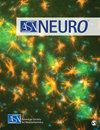神经炎性条件下三磷酸二磷酸酶2(NTPDase2)表达的体内外负调控
IF 3.7
4区 医学
Q2 NEUROSCIENCES
引用次数: 1
摘要
外核三磷酸二磷酸酶2(NTPDase2)将细胞外ATP水解为ADP,ADP是P2Y1、12、13受体的配体。本研究描述了NTPDase2在生理条件下成年大鼠大脑中的分布,以及在三甲基锡(TMT)诱导的海马神经退行性变中的分布。该研究还描述了原代星形胶质细胞和少突胶质细胞系OLN93中炎症介质对NTPDase2的调节。在生理条件下,NTPDase2蛋白在海马中含量最高,在富含突触的海马层的纤维星形胶质细胞和突触末梢中发现。在TMT诱导的神经退行性变中,NTPDase2mRNA在2-dpi时急剧下降,然后在7-dpi和21dpi时逐渐恢复到对照水平。通过免疫组织化学和双重免疫荧光测定,减少在齿状回(DG)最为明显,其中NTPDase2从DG多态层的突触突中退出,而表达在亚颗粒层的恢复最为深刻。关于NTPDase2基因表达的调节,促炎细胞因子IL-6、IL-1β、TNFα和IFNγ在OLN93细胞中负调节NTPDase2中的表达,而不改变原代星形胶质细胞中的表达。不同的细胞内在应激源,如细胞内能量储存的耗竭、氧化应激、内质网应激和蛋白激酶C的激活,也严重干扰NTPDase2基因的表达。总之,我们的研究结果表明,NTPDase2的表达和活性在神经退行性变和脑损伤中短暂停止,很可能是旨在促进细胞防御、存活和恢复的急性适应性反应的一部分。本文章由计算机程序翻译,如有差异,请以英文原文为准。
Expression of Ectonucleoside Triphosphate Diphosphohydrolase 2 (NTPDase2) Is Negatively Regulated Under Neuroinflammatory Conditions In Vivo and In Vitro
Ectonucleoside triphosphate diphosphohydrolase 2 (NTPDase2) hydrolyzes extracellular ATP to ADP, which is the ligand for P2Y1,12,13 receptors. The present study describes the distribution of NTPDase2 in adult rat brains in physiological conditions, and in hippocampal neurodegeneration induced by trimethyltin (TMT). The study also describes the regulation of NTPDase2 by inflammatory mediators in primary astrocytes and oligodendroglial cell line OLN93. In physiological conditions, NTPDase2 protein was most abundant in the hippocampus, where it was found in fibrous astrocytes and synaptic endings in the synaptic-rich hippocampal layers. In TMT-induced neurodegeneration, NTPDase2-mRNA acutely decreased at 2-dpi and then gradually recovered to the control level at 7-dpi and 21-dpi. As determined by immunohistochemistry and double immunofluorescence, the decrease was most pronounced in the dentate gyrus (DG), where NTPDase2 withdrew from the synaptic boutons in the polymorphic layer of DG, whereas the recovery of the expression was most profound in the subgranular layer. Concerning the regulation of NTPDase2 gene expression, proinflammatory cytokines IL-6, IL-1β, TNFα, and IFNγ negatively regulated the expression of NTPDase2 in OLN93 cells, while did not altering the expression in primary astrocytes. Different cell-intrinsic stressors, such as depletion of intracellular energy store, oxidative stress, endoplasmic reticulum stress, and activation of protein kinase C, also massively disturbed the expression of the NTPDase2 gene. Together, our results suggest that the expression and the activity of NTPDase2 transiently cease in neurodegeneration and brain injury, most likely as a part of the acute adaptive response designed to promote cell defense, survival, and recovery.
求助全文
通过发布文献求助,成功后即可免费获取论文全文。
去求助
来源期刊

ASN NEURO
NEUROSCIENCES-
CiteScore
7.70
自引率
4.30%
发文量
35
审稿时长
>12 weeks
期刊介绍:
ASN NEURO is an open access, peer-reviewed journal uniquely positioned to provide investigators with the most recent advances across the breadth of the cellular and molecular neurosciences. The official journal of the American Society for Neurochemistry, ASN NEURO is dedicated to the promotion, support, and facilitation of communication among cellular and molecular neuroscientists of all specializations.
 求助内容:
求助内容: 应助结果提醒方式:
应助结果提醒方式:


